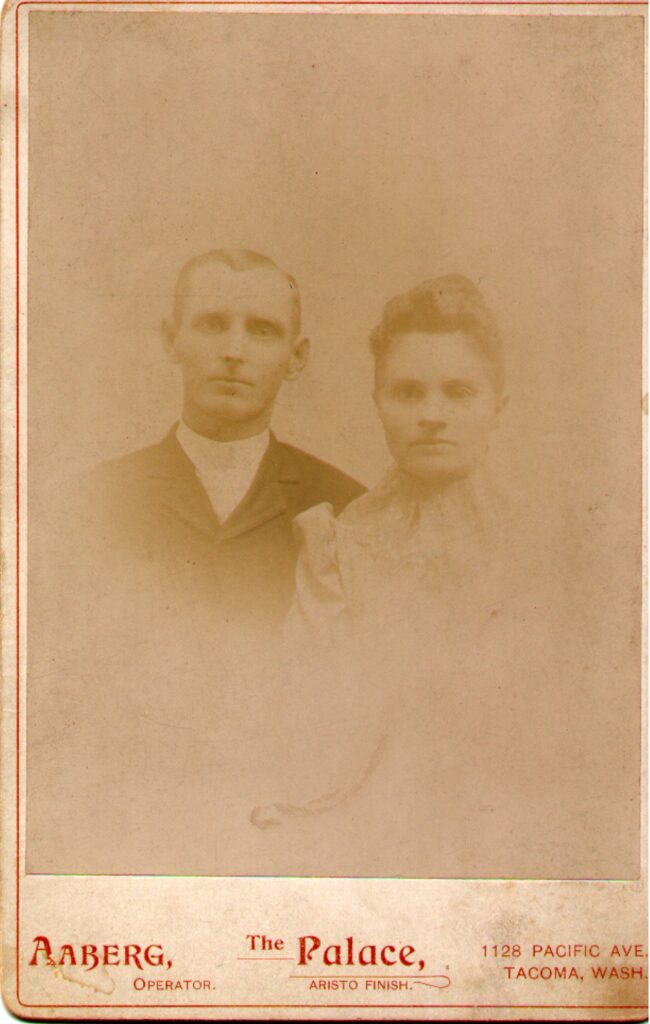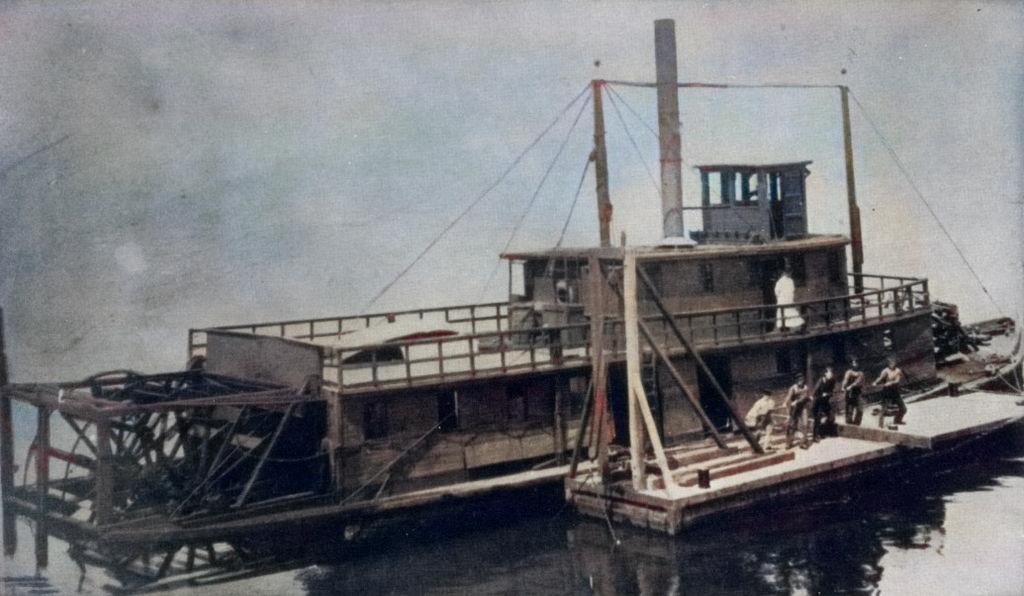
In the last half of the nineteenth century, several members of the Williams family migrated across the Mississippi and west all the way to Washington Territory. Most of their extended family would stay in Illinois and Tennessee, involved with the Baptist Church and their communities there, but these siblings were looking for something else in life.
The first to leave from Jefferson County, Illinois was the eldest daughter of Henry M. Williams and Judith Delia (Boyls) Williams, Mary Melvina Williams, soon after her marriage to William Barton ” WB” Kelley. They came with WB’s father and family and had 6 wagons, but were joined by others for part of the journey. They settled in Puyallup in about 1864, and he was a farmer, logger, school teacher, territorial legislator and became Pierce County Auditor, and then sheriff. Mary was the mother of six children, two of whom died in childhood.
The year Mary left home was the year her mother Judith gave birth to her last child, Mary’s baby brother Silas Ezra Williams. Mary’s mother died eleven years later, in 1875, and her father Henry seems to have gathered the rest of the children and headed south from Illinois to Tennessee, where he’d lived as a child. As a veteran of the Mexican war, Henry had been living with a chronic leg injury ever since he mustered out of the military. It was swollen and infected for twenty years and left him unable to farm. He’d driven an ox team and speculated on land to support his family. At the the death of his wife, he sold his land and moved away and died in Tennessee two years later.
Mary’s siblings Walter, John and Francis were the next to go west. They all seemed to have arrived in Washington Territory by 1883, five years after the death of their father. This was well before the Northern Pacific had opened its route through the Cascades over Stampede Pass and terminating in Tacoma, and just months before a route to Portland, Oregon began running trains. They would have taken the Oregon Trail, and travelled up the Cowlitz river to Olympia and then probably travelled by boat to Tacoma.

Walter Williams is found in the territorial census of 1883, working as a clerk in New Tacoma, an area that is now currently the downtown section of Tacoma, but was not the center of business at that time. New Tacoma and Tacoma– the settlement just east of Point Defiance– were merged in 1884. Walter and Alice Ivey, the woman he’d married in Tennessee eventually (by 1885) settled along the Toutle River in Cowlitz County near Castle Rock. His family was passionate about the outdoors and his eight children became skiers, snowshoers and early Forest Rangers.
John Ace Williams, known as JA, also married in Tennessee. He’d taken his wife Hattie and their two eldest children and made an attempt to start a dental practice in Mount Vernon, Illinois, near where he’d lived as a child, but by 1883, he also was in the Puget Sound area. I did not locate him in the territorial census of 1883, but he is mentioned as the builder of a steam boat, the Cuba, in Lewis and Dryden’s Marine History of the Pacific Northwest in the footnote on page 330, which was published in 1895. The Cuba, if it were built a year before the Estella, would have been built in 1883, but this is the only reference to that vessel I have ever found.
According to Lewis & Dryden, JA Williams was associated with the following vessels: Cuba, Estella, Messenger, Quickstep, Des Moines, Harry Lynn and Corona. He operated mail runs between small communities and Tacoma, for the most part. In the 1889 directory, JA was listed as the Captain of the steamer Estella. JA returned to dental practice in Puyallup about 1900, and then had offices in downtown Tacoma in the last decade of his life. His sons Wynne and John Henry worked on marine engines. By 1940, John Henry was working instead on airplane engines in Seattle.
Francis married at just age 16 in Illinois just a year before the death of her mother. She did not move to Tennessee. Her husband died, leaving her pregnant and with a 5 year old at age 24. She travelled west and was living in Tacoma by the time her second child was 7 months old, so it seems that she must have been travelling with a newborn. This was in either the fall of 1882 or early spring of 1883. She married a relation of her sister Mary’s husband by 1886. Her sons for whatever reason stayed away from the sea, but were railroad enginemen, an iron worker, and a truck driver. The Williams family tended to be mechanically minded.
Captain Edgar Williams was not a captain. “Captain” was the name bestowed on him by his parents at birth. He married at home, in 1875, just after his mother died, but before his father moved to Tennessee. His son George was born in Illinois the following year. We next find Cap and his wife Eliza farming in Kansas in 1880. Eliza died there four years later. While I have been able to trace Cap’s stepdaughter Abba past this time, I have been unable to find record of his son George who was alive in 1880. It is possible that he also died around the time that Eliza did. In the 1892 Washington territorial census, Cap is living with his brother Walter and his occupation is listed as engineer. I believe they were in Tacoma, but the listing only shows that they were in Pierce county. Then came this mention in the Tacoma Daily News (5/5/1897 Page 4):
INSANE AND INCENDIARY
Superintendent John McKenty, of the Pierce county poor farm, brought one of his inmates into town this morning, alleging that he was a victim of insanity. The man, who gave the name of Edgar Williams and is generally known as “Captain” Williams, has several times attempted to set fire to the buildings at the county farm, deluded by the idea that he was running an engine and must get up steam. He was received by Superintendent McKenna April 3, from the county hospital. After an examination before Judge Kean, which proved beyond doubt the impaired condition of the unfortunate man’s mind, he was committed to the insane asylum.
Captain Edgar Williams died in the Western State Hospital 19 Sep 1899. His cause of death was listed as dementia.
Katerina “Kate” Williams may have gone to Tennessee with her father, but was back in Illinois a year after his death, where she married. She and her husband farmed in Franklin County for about 10 years before they too moved to the Pacific Northwest with their four children. Her husband primarily worked with horses. Their son worked for the postal service and one daughter died young.
Alice Williams is missing from the 1880 US Census, at least so far. I keep looking. I believe she must have gone to Tennessee with her father, because she was only 13 when her mother died, but I can’t find any record. She married and lived in Jefferson County, Illinois until around 1889 before she and her family made their way to Washington. They lived for a time in Cowlitz County before moving to Sumner, in Pierce County, where they farmed. One son died in a construction accident while building power lines, and the others were bus drivers.
The youngest son was Silas Ezra Williams, and like his sister, Alice, I can’t find him in the 1880 US Census. He was age 11 when his mother died, and 13 when he lost his father. One of his elder brothers died the following year. I next find him in Tacoma Washington in 1885, aged 21 and his listed occupation is student. By 1886 and in years following, he is listed in Seattle and Tacoma city directories as an engineer, which meant he operated steam engines, likely on boats captained by his brother, John. A captain rode in the pilothouse and gave the engineer signals with the vessel’s bells:
Steam powered marine engines had to be thoroughly warmed up before a vessel was put in motion to prevent problems caused by condensation of steam on the cold interior surfaces of the engines. Warming up was accomplished by working the engine at a very slow speed while the vessel remained securely tied up to the wharf. Warming up might be carried on for up to half an hour before the vessel cast off. When the vessel was ready to leave, one jingle would signal the engineer to stop idling and place the engines on standby. Conversely, when the vessel was about to tie up for any length of time, one jingle would signal the engineer to go off standby. — A century of Paddlewheelers in the Pacific Northwest, the Yukon and Alaska, by Edwin Lloyd Affleck.
Around 1891, he moved to Cowlitz county, possibly working on boats in the Cowlitz River, which was the main highway to the Columbia River, Portland, and the Pacific Ocean, or on stationery steam engines in logging operations.
Silas Ezra, known as simply Ezra, was wedded to Clara DeElla Adams in what was apparently an arranged marriage. There was a shortage of single women in Washington Territory, and Clara, known as Ella, was willing to come west to marry Ezra. I believe they had a mutual friend who made the arrangement. Ezra traveled up to Skagit County, where Ella was staying with her sister and brother in-law and they were married. They made their home in Tacoma. Ezra was over 6 feet tall, and Ella was small of stature.



After their marriage, Ezra worked for the Woodland Lumber Company, which was based in Lacey, Washington. He also worked as the engineer on the steamer Zephyr, and then at the Tacoma Mill Company as an engineer and then as simply a laborer. They married at the beginning of the “Panic” of 1893 so there must have been hardships.




Silas Ezra Williams, Jr. was the only child born to Ezra and Clara. He was born in Tacoma in August of 1894. He was baptized the following summer, also in Tacoma. The family was still in Tacoma (or Seattle) when Ezra received his condensing steam engineering license in December 1897.
Although the surviving Williams siblings would remain in the Puget Sound area for the rest of their lives, by 1900, Ezra, Clara and their son Si were living in Denver, with Ezra working on train engines. They left the Pacific Northwest during the Klondike Gold Rush, which enriched Seattle, but not necessarily Tacoma. Ezra’s brother, Cap died in 1899, and his brother John stopped his marine activity and returned to dentistry around the same time. I’m not sure what made Ezra give up his work on marine vessels. He and his family did not stay long in Denver. They ended up in Southern California, where Ezra worked on stationery steam engines and also owned a poultry ranch. His granddaughter Millie remembered him as having worn overalls much of the time and said he was very kind and made her feel safe. Ezra and Ella returned to the Tacoma area just once that I know of, to visit family and attend the wedding of their son Si, who was stationed at Camp Lewis at the time, to Alberta Peasgood in 1918.